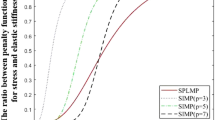Abstract
This paper presents an application of a monomial approximation method for solving systems of nonlinear equations to the design of civil engineering frame structures. This is accomplished by solving a set of equations representing the state known as “fully-stressed design”, where each member of the structure is stressed to the maximum safe allowable level under at least one of the loading conditions acting on it. The monomial approximation method is based on the process of condensation, which has its origin in geometric programming theory. A monomial/Newton hybrid method is presented which permits some of the design variables to be free in sign, while others are strictly positive. This hybrid method is well suited to the structural design application since some variables are naturally positive and others are naturally free. The proposed method is compared to the most commonly used fully-stressed design method in practice. The hybrid method is shown to find solutions that the conventional method cannot find, while doing so with less computational effort. The impact of this approach on the activity of structural design is discussed.
Similar content being viewed by others
References
American Institute of Steel Construction, Inc., Manual of Steel Construction, Allowable Stress Design, 9th ed. (1989).
D.W. Baker, Application of the geometric inequality to the solution of systems of nonlinear equations, Ph.D. thesis, Colorado School of Mines, Golden, CO (1980).
S.A. Burns, Generalized geometric programming with many equality constraints, Internat. J. Numer. Methods Engrg. 24 (1987) 725–741.
S.A. Burns, The monomial method: extensions, variations, and performance issues, Internat. J. Numer. Methods Engrg. 37 (1994) 2093–2107.
S.A. Burns, The monomial method and asymptotic properties of algebraic systems, Internat. J. Numer. Methods Engrg. 37 (1994) 3939–3948.
S.A. Burns and A. Locascio, A monomial-based method for solving systems of nonlinear algebrraic equations, Internat. J. Numer. Methods Engrg. 31 (1991) 1295–1318.
S.A. Burns and K.M. Mueller, Solving systems of nonlinear equations with both free and positive variables, Internat. J. Numer. Methods Engrg. 46 (1999) 1987–1996.
H. Cross, The relation of analysis to structural design, Trans. ASCE 62 (1935) 1363–1408.
R.J. Duffin, E. Peterson and C. Zener, Geometric Programming (Wiley, New York, 1967).
R.J. Duffin and E.L. Peterson, Geometric programming with signomials, J. Optim. Theory Appl. 11 (1973) 3–35.
D.R. Greening, A proof of convergence for a condensation approach to the solution of nonlinear equations, M.S. thesis, Colorado School of Mines, Golden, CO (1982).
K.M. Mueller, S.A. Burns and M.A. Savageau, A comparison of the monomial method and the S-system method for solving systems of algebraic equations, Appl. Math. Comput. 90 (1998) 167–180.
E.L. Peterson, The solution of posynomial equations, Technical Report #010887-01, Department of Mathematics and Graduate Program in Operations Research, North Carolina State University, Raleigh, NC (1987).
M.J. Rijckaert and X.M. Martens, A condensation method for generalized geometric programming, Math. Programming 11 (1976) 89–93.
M.A. Savageau, Finding multiple roots of nonlinear algebraic equations using S-system methodology, Appl. Math. Comput. 55 (1993) 187–199.
R.K. Tulk, Transformed Newton's method, Ph.D. thesis, Colorado School of Mines, Golden, CO (1976).
T.W. Wall, A numerical algorithm for the solution of chemical equilibrium problems, M.S. thesis, Colorado School of Mines, Golden, CO (1984).
T.W. Wall, D. Greening and R.E.D. Woolsey, Solving complex chemical equilibria using a geometric-programming based technique, Operations Research 34 (1986) 345–355.
Author information
Authors and Affiliations
Rights and permissions
About this article
Cite this article
Burns, S.A., Mueller, K.M. Design of Civil Engineering Frame Structures Using a Monomial/Newton Hybrid Method. Annals of Operations Research 105, 21–35 (2001). https://doi.org/10.1023/A:1013393213240
Issue Date:
DOI: https://doi.org/10.1023/A:1013393213240




